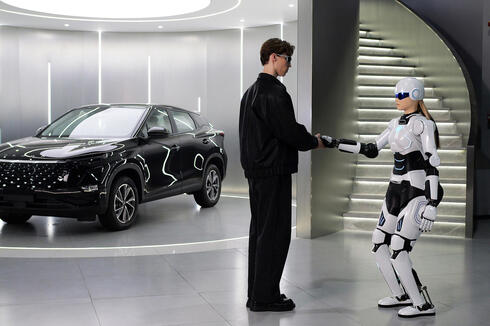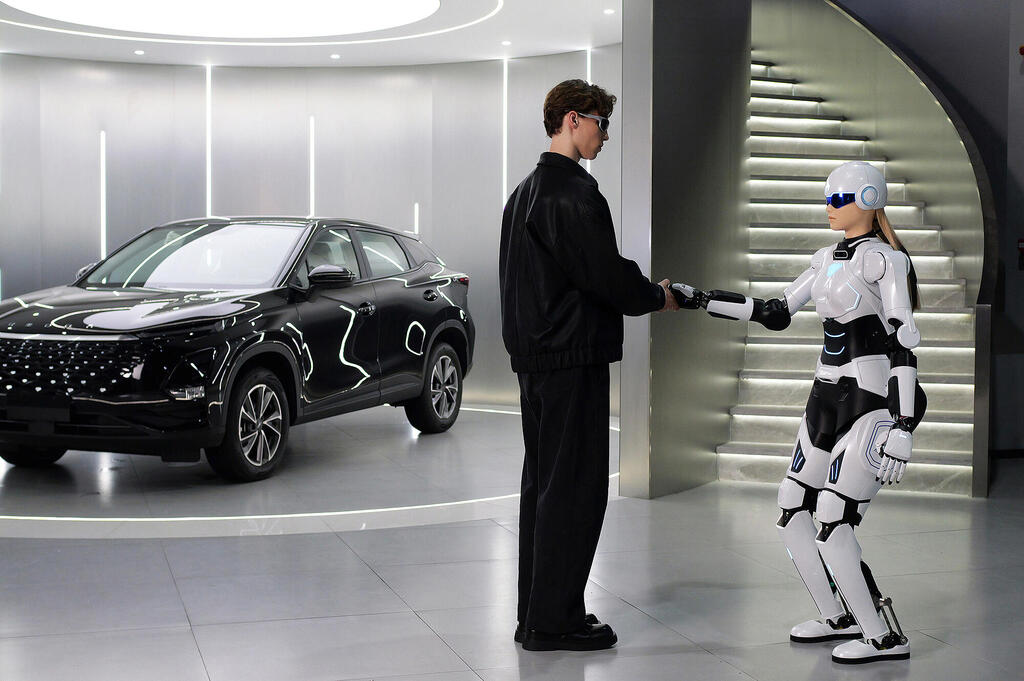
China’s robot army is coming for the auto industry
At the Shanghai Auto Show, humanoid machines stole the spotlight, now they’re headed to the factory floor.
The Shanghai Auto Show, which took place last month, is now considered the most important automotive exhibition in the world. Chinese automakers are emerging as a dominant global force. Once content with their home market, companies like BYD, Geely, Chery, and Changan are now preparing for a full-scale international expansion. Their primary weapon is a dizzying array of new models, but that's not all. At its booth, Changan, which also sells vehicles in Israel, displayed a lineup of robots, including a dog-like robot designed to showcase the company’s commitment to advanced automation.
According to Changan, it plans to invest $13.7 billion over the next decade in developing “advanced robotic systems.” It’s not alone: Omoda, a Chinese car brand imported into Israel by Colmobil, unveiled a humanoid sales robot at the show named “AiMOGA,” styled with long blond hair and dubbed “Maureen.” According to the company, Maureen can recognize customers, assist with purchasing decisions, and was even “trained” as part of Omoda’s sales team in Kuala Lumpur, Malaysia, where she also learned to mix drinks for guests. Reportedly, she’s quite good at it.
These are not crude machines limited to basic motions. Omoda and Changan’s humanoid robots are autonomous, bipedal, and capable of holding simple conversations.
It’s worth noting that China isn’t the first to explore humanoid robotics. At Tesla’s dealership in Netanya, Israel, you can see a model of Optimus, the 173-cm humanoid robot unveiled in 2022. Hyundai, in collaboration with Boston Dynamics, introduced Spot, a robotic guard dog, about two years ago. But here’s the difference: Optimus and Spot are prototypes. China’s robots are already being deployed in sales and manufacturing roles, and will soon be building cars.
The Perfect Manufacturing Process
According to a 2024 Morgan Stanley report titled “Mapping the Humanoid Robot Value Chain,” 52% of companies in the humanoid robotics sector are based in China. That share is expected to rise, with China projected to lead the global humanoid robotics market, which could reach 12 billion yuan ($1.64 billion) by 2030. GGII, a Chinese analyst firm, estimates that 12,400 humanoid robots will be deployed across China this year alone.
In March, Li Qiang, Premier of the People’s Republic of China, declared that China would “vigorously and continuously” support robotics development. This is not mere rhetoric: according to Chinese media, the government has earmarked $137 billion for robotics R&D in the coming years.
Omoda and Changan’s humanoid robots are friendly and polite helpers, but behind the scenes, the country’s automakers are preparing for much deeper integration of robotics into their operations. In December, GAC announced plans to introduce humanoid robots into its Chinese factories. These robots, intended for “limited internal use,” are called GoMate and are equipped with legs on wheels, articulated arms, and a head. They are said to be capable of performing complex tasks. Xpeng’s humanoid robot, “Iron,” weighs 70 kilograms and can execute 200 intricate movements using its joint network. Nio’s robot, developed in collaboration with UBtech, can perform quality control tasks like checking seat belts and door locks and affixing badges to finished vehicles. Zeekr has also begun employing humanoid robots in its production lines.
As of December 2024, China’s auto industry employed 4.7 million workers, according to CEIC. Unlike unionized workers in Germany, South Korea, or the U.S., Chinese auto workers have limited protections. They need to eat and sleep, and they can’t work around the clock. Robots can.
Western automakers are also investing in robotics - Mercedes-Benz recently invested in Apptronik with the aim of integrating robots into its factories. However, strong unions in Germany and elsewhere may limit the extent of such automation. In China, resistance to robot labor is unlikely to be a major barrier.
China’s robot push mirrors its investment in eVTOL (electric vertical takeoff and landing) aircraft: while Western automakers invested in engine efficiency, safety, and styling, Chinese companies focused on transfer-friendly technologies like AI, recognition sensors, lithium-ion batteries, and connected systems. According to Xpeng CEO He Xiaopeng, humanoid robots share “70% similarity” with autonomous, AI-powered vehicles, what he calls “AI cars.” He says robot-based manufacturing is “one of the three pillars” of the company’s strategy.
The primary goal of robotic manufacturing is reducing labor costs. According to a recent study by Oliver Wyman, the average labor cost per vehicle is $3,307 in Germany, $1,341 in the U.S., $789 in South Korea, and $597 in China. In Morocco, the figure drops to $106. For BYD, the average selling price of a vehicle last year was $16,700, already low. Replacing workers with robots will only drive that number lower.
Will robots eliminate human jobs in auto factories? Not entirely. The automotive industry still requires people for design, oversight, and high-precision tasks. But robots will take on a growing share of work, and in China, they already are. The country’s automakers may soon outpace their Western rivals, not only in exports, but in building the future itself.














